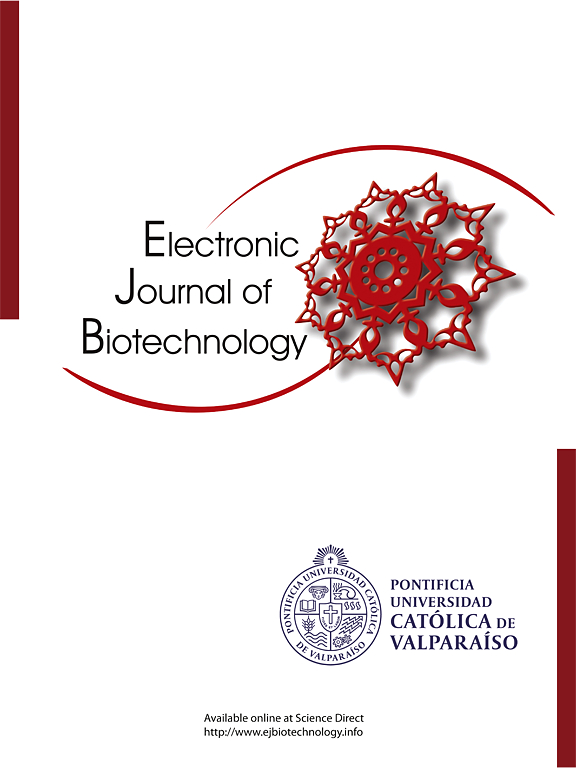岛Talaromyces islandicus AUMC 11391提高淀粉酶产量的条件优化
IF 2.5
4区 生物学
Q3 BIOTECHNOLOGY & APPLIED MICROBIOLOGY
引用次数: 0
摘要
为了满足不断增长的生物技术需求、气候变化和耗竭的水供应,必须开发能够在高温和盐浓度下生存的淀粉酶。淀粉酶是最重要的酶,约占国际酶市场的25-33%,在许多工业中发挥着重要作用。结果在pH 6.0、30℃条件下,以硝酸钠为供氮源,培养8 d后,利用岛Talaromyces islandicus AUMC 11391在增加浓度为232±36 U/mL的条件下产生淀粉酶。所得酶用70%硫酸铵进行部分纯化,然后透析。在pH 5.0和55℃条件下,淀粉酶活性达到峰值(992.14±80 U/mg蛋白)。Cu、Co、Fe、Ni、Ca和Zn在pH 5.0和55°C条件下对淀粉酶活性的激活作用分别为134.57、123.1、115.4、109.76、105.43和103.2%。Km和Vmax分别为132.1 mM和60.6µmol/min。岛霉AUMC 11391 s-淀粉酶对玉米、高粱、小麦、水稻和燕麦原料淀粉的水解率分别为12.3%、113.7%、32.25%、34.67%和73.6%。结论从岛霉AUMC 11391中提取的α-淀粉酶具有提高产量和有益性能的优点,有望满足目前多种工业工艺对淀粉酶的需求。如何引用:Al - Bedak o.a.m., Moharram a.m.。, Ameen F,等。岛Talaromyces islandicus AUMC 11391提高淀粉酶产量的条件优化。中国生物医学工程学报(英文版);2009;16。https://doi.org/10.1016/j.ejbt.2025.01.008。本文章由计算机程序翻译,如有差异,请以英文原文为准。

Optimizing conditions for augmented production of amylase by Talaromyces islandicus AUMC 11391
Background
To satisfy rising biotechnological needs, climate change, and depleting water supplies, amylases that can survive high temperatures, and salt concentrations must be developed. Amylases are the most important enzymes that comprise approximately 25–33% of the international enzyme market and have a great role in many industries.
Results
In this investigation, Talaromyces islandicus AUMC 11391 was used to produce amylase in submerged fermentation (SmF) in an augmented concentration of 232 ± 36 U/mL after 8 d of incubation at pH 6.0 and 30°C using sodium nitrate as a nitrogen supply. The obtained enzyme was partly purified employing 70% ammonium sulfate and then dialysis. The activity of the produced amylase exhibited reached the peak (992.14 ± 80 U/mg protein) at pH 5.0 and 55°C. Cu, Co, Fe, Ni, Ca, and Zn had an activating effect on the activity of the amylase enzyme at pH 5.0 and 55°C by 134.57, 123.1, 115.4, 109.76, 105.43, and 103.2%, respectively. The Km and Vmax were recorded as 132.1 mM and 60.6 µmol/min, respectively. T. islandicus AUMC 11391′s-amylase hydrolyzed the raw starch of maize, sorghum, wheat, rice, and oat at rates of 12.3, 113.7, 32.25, 34.67, and 73.6% in contrast to the soluble starch.
Conclusions
This enhanced α-amylase from T. islandicus AUMC 11391 looks to be a potential option to meet the present amylase requirements of a variety of industrial processes because of its improved production and beneficial properties.
How to cite: Al - Bedak O.A.M., Moharram AM., Ameen F, et al. Optimizing conditions for augmented production of amylase by Talaromyces islandicus AUMC 11391. Electron J Biotechnol 2025;75. https://doi.org/10.1016/j.ejbt.2025.01.008.
求助全文
通过发布文献求助,成功后即可免费获取论文全文。
去求助
来源期刊

Electronic Journal of Biotechnology
工程技术-生物工程与应用微生物
CiteScore
5.60
自引率
0.00%
发文量
50
审稿时长
2 months
期刊介绍:
Electronic Journal of Biotechnology is an international scientific electronic journal, which publishes papers from all areas related to Biotechnology. It covers from molecular biology and the chemistry of biological processes to aquatic and earth environmental aspects, computational applications, policy and ethical issues directly related to Biotechnology.
The journal provides an effective way to publish research and review articles and short communications, video material, animation sequences and 3D are also accepted to support and enhance articles. The articles will be examined by a scientific committee and anonymous evaluators and published every two months in HTML and PDF formats (January 15th , March 15th, May 15th, July 15th, September 15th, November 15th).
The following areas are covered in the Journal:
• Animal Biotechnology
• Biofilms
• Bioinformatics
• Biomedicine
• Biopolicies of International Cooperation
• Biosafety
• Biotechnology Industry
• Biotechnology of Human Disorders
• Chemical Engineering
• Environmental Biotechnology
• Food Biotechnology
• Marine Biotechnology
• Microbial Biotechnology
• Molecular Biology and Genetics
•Nanobiotechnology
• Omics
• Plant Biotechnology
• Process Biotechnology
• Process Chemistry and Technology
• Tissue Engineering
 求助内容:
求助内容: 应助结果提醒方式:
应助结果提醒方式:


